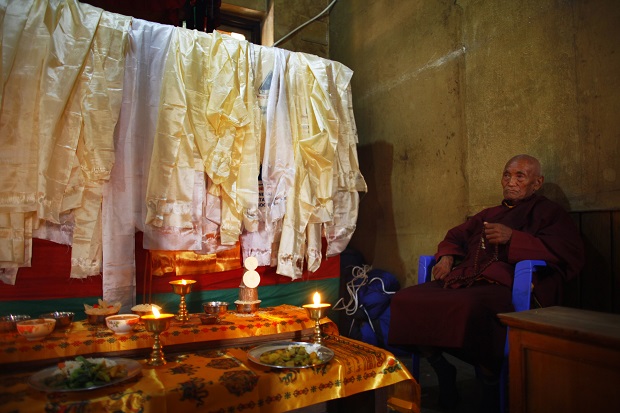
A Buddhist monk performs rituals next to a casket containing the dead body of Nepalese mountaineer Ang Kaji Sherpa, killed in an avalanche on Mount Everest, offer prayers at the Sherpa Monastery in Katmandu, Nepal, Sunday, April 20, 2014. AP
KATMANDU, Nepal — Sherpa guides on Mount Everest are considering a boycott after the deadliest avalanche in the mountain’s history, a move that could seriously disrupt the rest of the climbing season, a mountaineering official said Monday.
Several Sherpas already have quit while others are still deciding whether to boycott following Friday’s avalanche, said Ang Tshering of the Nepal Mountaineering Association.
The disaster killed at least 13 Sherpas when a block of ice tore loose from the mountain and triggered an avalanche that ripped through teams of guides hauling gear. Three other Sherpas remain missing and are presumed dead.
Funerals were planned for later Monday.
“After losing so many of our brothers and friends it is just not possible for many of them to continue,” said Pasang Sherpa, who was not among those caught in the avalanche. “So many of us are scared, our family members are scared and asking us to return.”
All of the victims were from Nepal’s ethnic Sherpa community, which relies heavily on the country’s alpine trekking and climbing industry, with many making a living as climbing guides and others catering to foreign visitors by providing restaurants, equipment or transportation.
In the wake of the avalanche, the Sherpas have expressed anger that there has not been a bigger response from Nepal’s government, which profits from the permit fees charged to the climbing expeditions.
The government has announced an emergency aid of 40,000 rupees ($415) for the families of the deceased climbers. On Monday, Deputy Prime Minister Prakash Man Singh said the government is working to help the Sherpas.
“It is not true the government does not care,” he said. “We have been working with rescue from the very beginning. We will do what we can, keeping with the standard practice to provide compensation. ”
Tshering said there were about 400 foreign climbers from 39 expedition teams on the mountain and equal number of Sherpas guides, along with many more support staff such as cooks, cleaners and porters in the base camp.
The Tourism Ministry, which handles the mountaineering affairs, said it has not been told of any cancellations by expedition teams, said Maddhu Sunan Burlakoti, head of the Nepalese government’s mountaineering department.
Without the guides, it would be near impossible for the expedition teams to continue.
Attempts to reach the 8,850-meter (29,035-foot) peak of Everest were expected to start next month, and the Sherpas were preparing for that by attaching ropes and fixing climbing routes above the base camp when the avalanche hit.
Survivors recalled scenes of panic and chaos, describing how they dug through snow with their hands and ice axes in hopes of finding their friends alive.
Nepal’s tight-knit climbing community has been left reeling and struggling to make sense of the disaster — an accident the climbers say could have happened to any one of them.
Hospitals in Katmandu were treating four survivors of the avalanche for broken bones, punctured lungs and other injuries.
Hundreds of people, both foreigners and Sherpas, have died trying to reach the world’s highest peak. About a quarter of them were killed in avalanches, climbing officials say.
The worst recorded disaster on Everest had been a fierce blizzard on May 11, 1996, that caused the deaths of eight climbers, including famed mountaineer Rob Hall, and was later memorialized in a book, “Into Thin Air,” by Jon Krakauer.
More than 4,000 climbers have reached the top of Everest since 1953, when the mountain was first conquered by New Zealander Edmund Hillary and Sherpa Tenzing Norgay.
RELATED STORIES
Bad weather halts rescue after deadliest Everest disaster